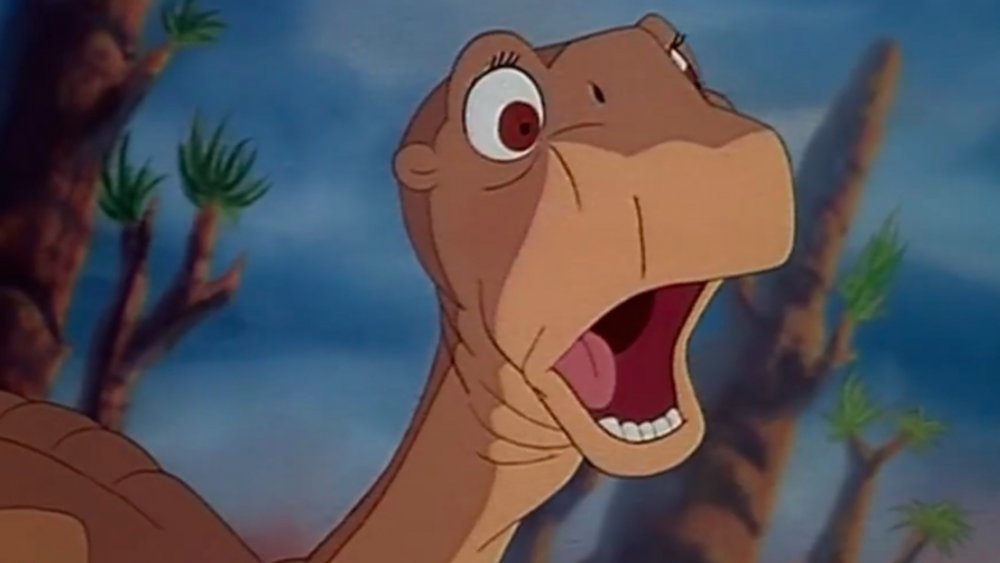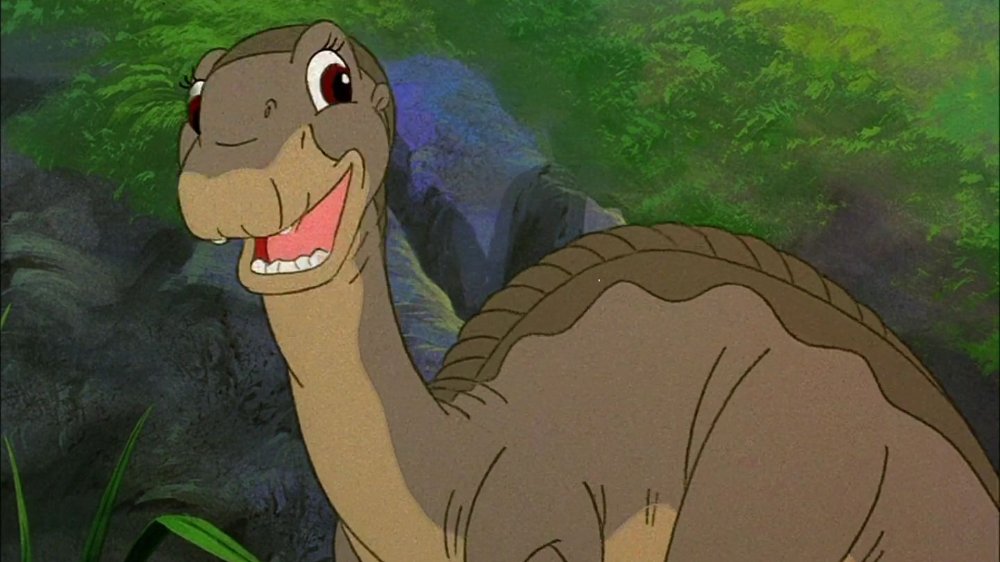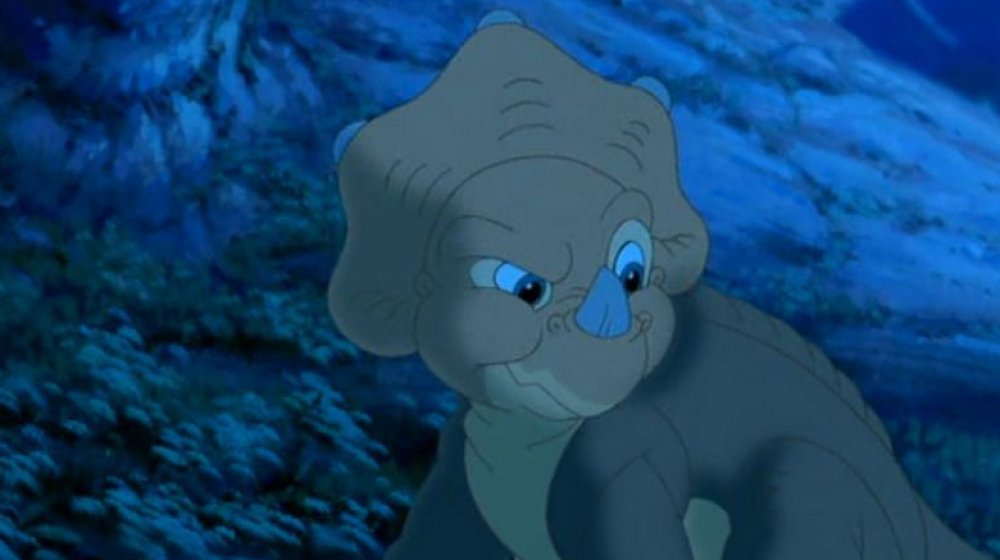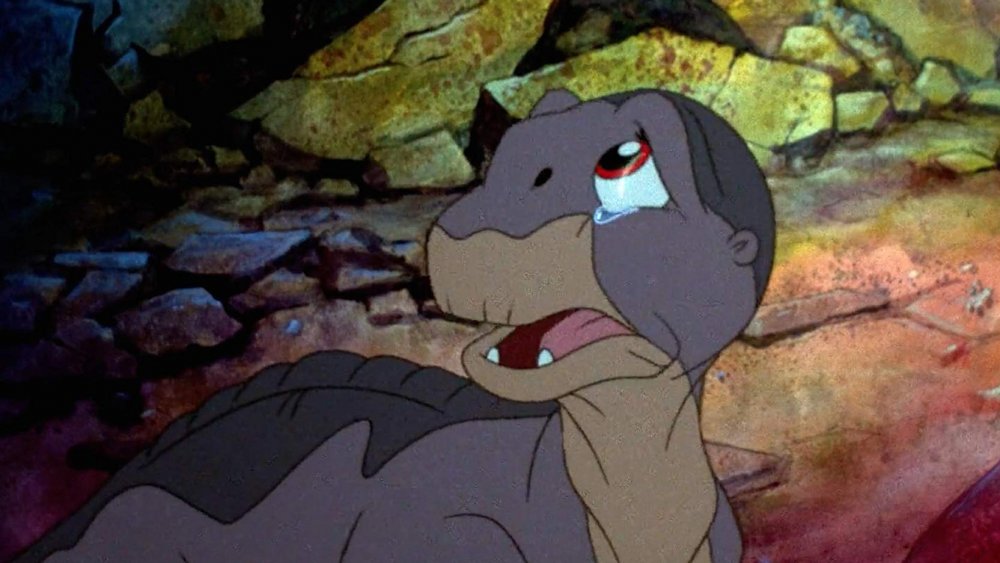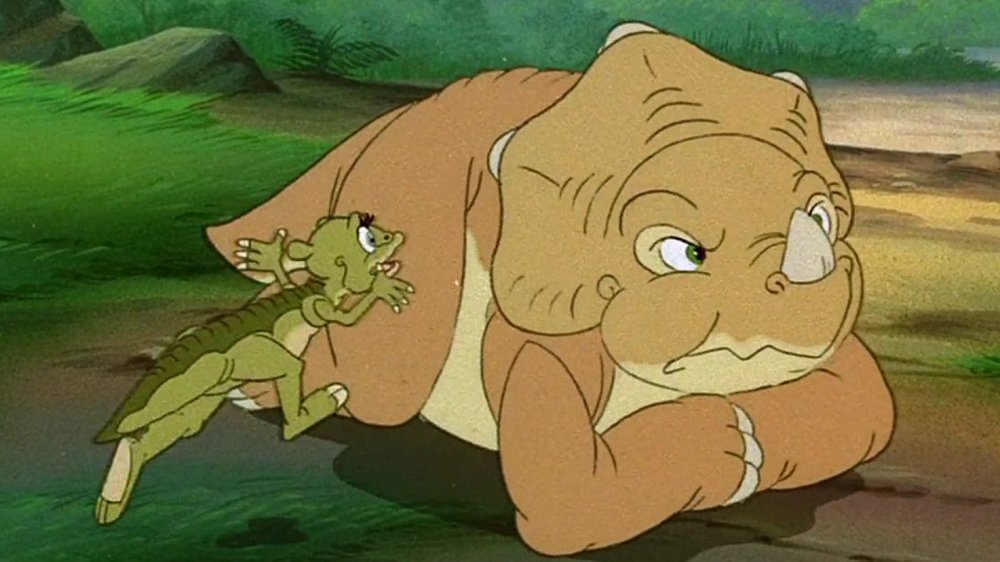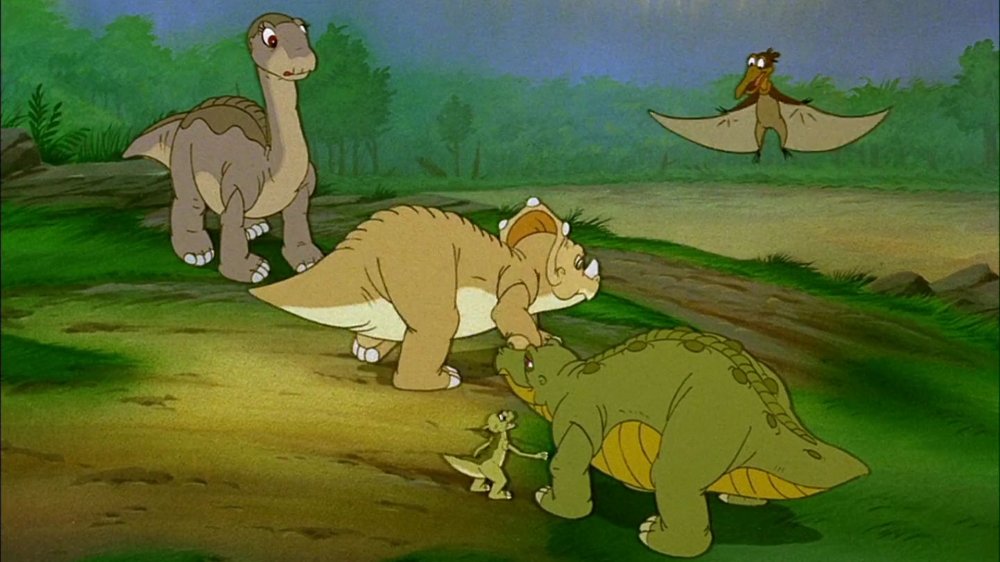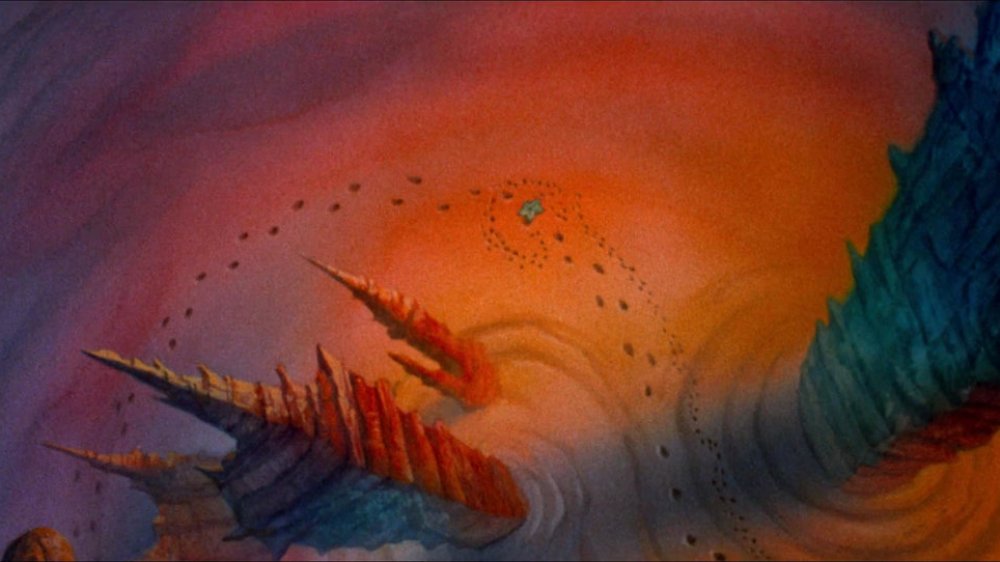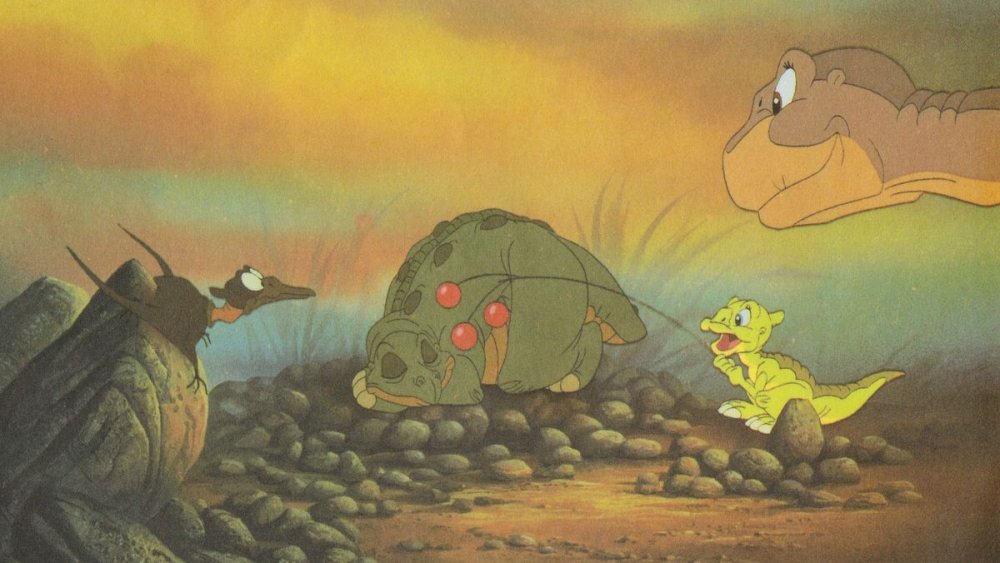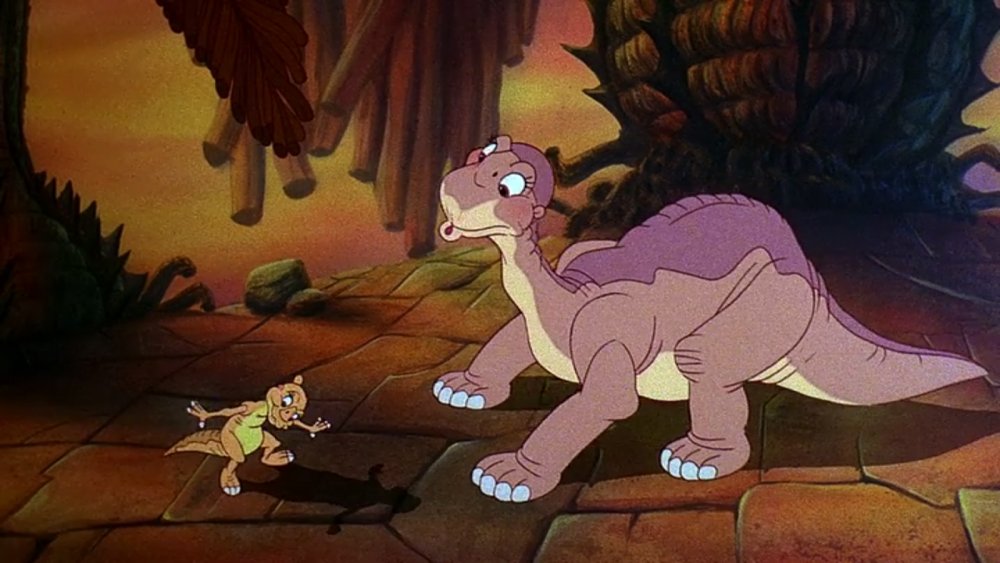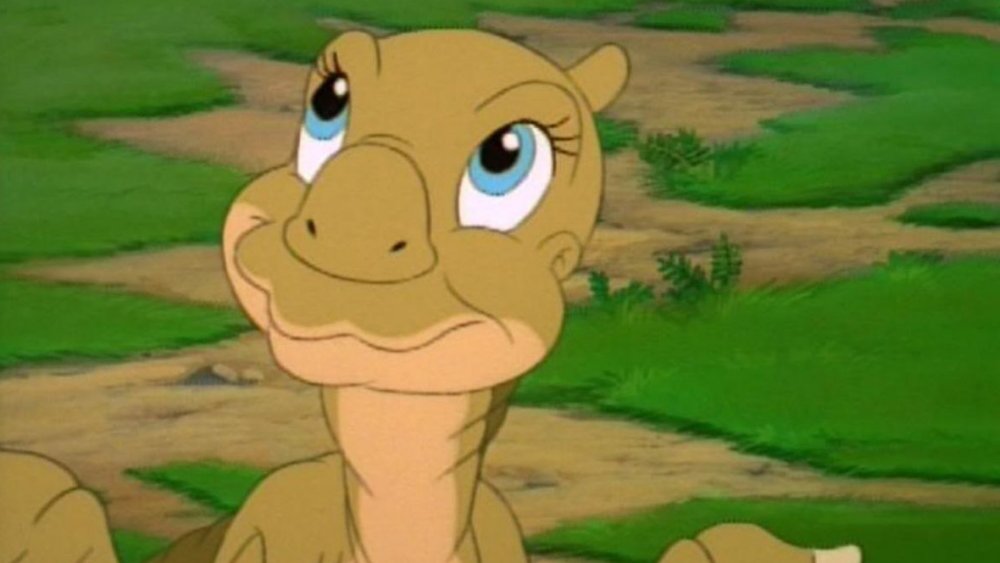Things Only Adults Notice In The Land Before Time
It is an undeniable truth that kids love dinosaurs. There's just something about these gargantuan prehistoric proto-reptiles that fascinates young people like nothing else — and long before Jurassic Park could scare the pants off budding baby paleontologists, there was the 1988 animated feature The Land Before Time, which has since been canonized as a classic for generations of tricera-tots. It was so successful that it spawned more than a dozen direct-to-video sequels, plus a television series and even a video game — not to mention kicking off a dinosaur media obsession with films like We're Back and Dinosaur, and television series like Jim Henson's bizarre puppet sitcom Dinosaurs.
But The Land Before Time is distinct in that it was really geared toward the very young, many of whom might not have even realized all the reasons they loved it so much. But adults can still appreciate the ways in which The Land Before Time shaped their childhood and their understanding of the natural world.
Bluth, Lucas, and Spielberg
Most children don't pay much attention to who's creating the films they love. But for decades, Don Bluth had a hand in a great deal of the most beloved animated movies, from his work with Disney starting in 1959 right up through to today — he's currently working on Dragon's Lair: The Movie, despite the fact that he's in his 80s. Today's adults can look back fondly on films like The Secret of NIMH, An American Tail, and All Dogs Go To Heaven, but modern kids are unlikely to recognize these titles as readily, and probably wouldn't necessarily recognize that they were all directed by the same person. The Land Before Time is another on this list of animated classics, and Bluth isn't the only impressive name on its pedigree. The film's executive producers were George Lucas and Steven Spielberg, Hollywood elites who had already collaborated on fan-favorite franchises like Star Wars and Indiana Jones. All three of these men are meaningful figures to anyone over a certain age, but the juice box crowd just cares about how Littlefoot and his friends are going to make it to the Great Valley.
A series of unfortunate sequels
When kids become obsessed with something, they go all in. They want to consume as much of whatever their passion is as possible. How many parents have lamented having to watch the same movie over and over again, or listen to the same saccharine children's tune ad nauseam? Because kids, already prone to dinosaur fascination, were so enthralled by the original The Land Before Time, the studio decided to continue to spin it off in a series of direct-to-video sequels — all of which are musicals unlike the original, whose tone does not particularly lend itself to upbeat melodies. Unfortunately, Bluth, Lucas, and Spielberg all opted to not be involved in the ensuing media works, and the absence of their expertise (and probably the absence of a healthy budget) prove to weaken these further narratives. But again, kids are less likely to care about overall quality when they're very young, opting to enjoy more of their favorite characters regardless of how they're presented.
A subtle balancing act
One of the aspects that sets the original film apart from its sequels is the way it deals with balancing heavy matters like loss, tragedy, and imminent danger with the sense of lighthearted fun that comes part and parcel with childhood. At the outset of the film, protagonist Littlefoot must contend with his mother's violent onscreen death. She gives him the gift of a "tree star," a star-shaped leaf, and tells him that he must find his grandparents in the Great Valley, where he can live freely without worrying about the blight sweeping the land. An elderly dinosaur named Rooter reassures Littlefoot, telling him that this is part of the great circle of life — a sentiment that would be echoed a few years later in Disney's The Lion King.
On Littlefoot's journey, he meets with other young dinosaurs without their parents, having been either orphaned or otherwise separated. These children must brave their way through a harsh, dying landscape to a promised land that may not even exist. Though a lot of this seems really heavy, the intended audience is learning important lessons about grappling with life's tragedies, in between enjoying a gripping adventure story starring children their own age. Adults can more readily recognize the benefit of this lesson, made easier for the children in their lives by being administered gently with consideration for emotional growth.
A lesson in diversity
Along with lessons about the various cycles of life, The Land Before Time provides a useful lesson about navigating differences. When Littlefoot and Cera first meet, the aggressive triceratops exclaims, "Threehorns never play with Longnecks!" Over the course of the movie, however, all the dinosaurs of differing backgrounds must overcome their inherent differences to meet their collective goal: to make it to the Great Valley where they won't have to scrounge so desperately for food.
Of course, this only applies to herbivorous dinos, as the crew continually must avoid and eventually outsmart the dreaded Sharptooth. In later installations of the franchise, the baby Sharptooth, Chomper, is introduced, teaching an even more complicated lesson in tolerance for others. Since the film is intended for very young kids, there's a fair chance that many of them have had few interactions with people outside their immediate families. Adults are likely to recognize the benefits of teaching this lesson early on, when young minds are still open and accepting.
Scientific flaws
Everyone knows that one kid who can rattle off all the polysyllabic names of various dinosaurs without even taking a breath. But children don't necessarily have a grasp of timing when it comes to which dinosaurs lived when, and though The Land Before Time does a great job of fueling their curiosity, it isn't terribly scientifically accurate. Ignoring the fact that modern research indicates that most dinosaurs were probably feathered (something which wasn't commonly accepted at the time the film came out), the dinosaur characters themselves were not likely to have all coexisted at the same point in time.
Like a lot of ancient and prehistoric history, getting a grip on how vast the timeline is can be complicated for adults as much as kids, but adults are more likely to have a better sense of scale than their younger counterparts. Littlefoot, an apatosaurus, and Spike, a stegosaurus, would have lived during the Late Jurassic period, while their friends Ducky (saurolophus), Petrie (pteranodon — and not technically a dinosaur!), and Cera (triceratops) lived during the Late Cretaceous period — along with the dreaded "Sharptooth" T. Rex.
Art appreciation
Children aren't always able to articulate why something catches their eye, and in the case of a cartoon, chances are they'll be most focused on the cute moving characters than anything else. But adults are more likely to recognize the incredible artistry that went into something like the lush, painterly backgrounds in The Land Before Time. In our modern era, we're distanced from a world populated solely with plants and animals, but the animators working under Bluth were able to bring the landscape of the prehistoric age to life beautifully, utilizing rich colors and expert lighting to create incredible works of art for the film's stalwart child-dinos to traipse across. Bluth's directorial efforts always have a distinct aesthetic, but credit must be given to the illustrators and animators who provided such stunning settings, especially since their target audience isn't likely to think much about the incredible beauty of their work until they're a little older.
Climate crisis
Everyone knows the dinosaurs went extinct. Indeed, to children they may as well be mythological beasts like dragons, so far are they from our current reality. But the threat of extinction is not something most children get too hung up on, with their lives so new and full and exciting. Adults, however, will likely be far more aware of our world's current climate concerns, knowing that the Earth goes through cycles of death and renewal — that circle of life Rooter tells Littlefoot about when he tries to console him over his mother's death.
So even though the children fear Sharptooth and his very real, physical threat to their wellbeing, it's nature running its course that is the real "villain" of the film. Even Sharptooth needs to eat — and what meager meals the children make, as they can barely feed themselves throughout the course of the film. Today's children are more eco-conscious than their parents might have been, but even if they know to recycle and reduce their waste, they are likely to lack the fear that comes with knowing that this planet is changing in often frightening ways.
Musical inclinations
The initial The Land Before Time isn't a musical, but grown-ups in the know will appreciate that the score was written by Oscar-winning composer James Horner. Prior to The Land Before Time, Horner was responsible for the scores to such films as Star Trek II: The Wrath of Khan, Aliens, and another Don Bluth film, An American Tail. Afterward, he had his hand in a couple more cult animated classics, We're Back: A Dinosaur Story and The Pagemaster, which echo a lot of The Land Before Time's themes of peril and adventure. And of course, he was nominated for an Oscar for his work in major dramatic films like Braveheart, Apollo 13, and Titanic — taking home not only the Oscar for James Cameron's nautical disaster romance, but also a Golden Globe and a Grammy Award.
Horner was clearly a very prolific composer, but he isn't the only big name in The Land Before Time's music credits. The incomparable Motown legend Diana Ross lent her incredible voice to the main theme song, "If We Hold On Together." Even in 1988, young kids probably weren't too hung up on Ross's star power, and that's even truer today — but their parents will have a better idea of her impact on the world of music.
The death of Ducky
Although The Land Before Time deals well with the subject of death and loss, many parents still try to shield their children from the very worst of the tragedies plaguing our world. Unfortunately, such tragedy actually touched the cast of The Land Before Time with the horrific murder of Judith Barsi, the ten-year-old voice actress behind Ducky. Barsi and her mother were killed by her father, who then shot himself as well, only a few months before The Land Before Time's theatrical premiere. This piece of sad news is not likely to affect a modern childhood audience, for whom 1988 exists as merely a distant time and place. But anyone alive at the time of the film's release, regardless of age, is better equipped to remember the news coverage and general mood surrounding this tale of a young talent whose voice was taken too soon.
